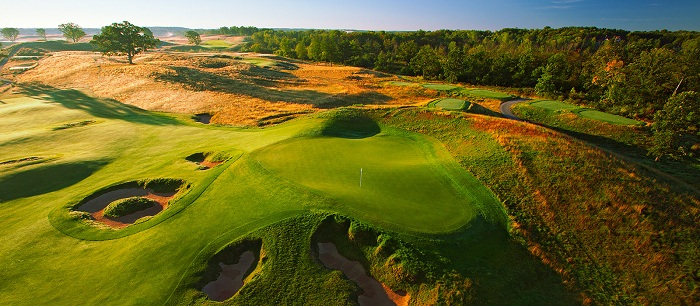Erin Hills to host Wisconsin’s first U.S. Open

Erin Hills is a golf course in the north central United States, located in Erin, Wisconsin, 35 miles northwest of Milwaukee. It is scheduled to host the 117th U.S. Open in 2017/ Photo: Erinhills.com
America’s 30th state is no stranger to major championship golf in the modern era with three PGA Championships staged at Whistling Straits on the shores of Lake Michigan, in 2004, 2010 and most recently in 2015, when Australian Jason Day held off the mighty challenge of Jordan Spieth to capture his first major.
Wisconsin was also host to a PGA Championship way back in 1933 when as a matchplay event, Gene Sarazen captured his third title with a 5/4 triumph over Willie Goggin.
So far as U.S. Opens are concerned however, this will a highly-anticipated first staging of the national championship in the state and excitement has been building since the venue was announced as host back in 2010.
“Erin Hills is in the Kettle Moraine region of Southern Wisconsin which is a nice rolling, topsy turvy piece of topography carved out by glaciers 10,000 years ago.” Erin Hills Competition Director John Morrisset said.
“We’re about 35 miles northwest of downtown Milwaukee so we have the best of both worlds in that when you’re out here, you feel like you’re in the middle of nowhere in rural Wisconsin but in reality you’re not far from a very big city."
The announcement that the U.S. Open would be coming to Erin Hills has stagnated any plans home-grown PGA TOUR star and 2017 U.S. Presidents Cup captain Steve Stricker had to slide gracefully into semi-retirement.
Stricker turned 50 earlier this year and but for the Open coming to at Erin Hills, might have had his pipe lit and bed socks on more regularly with only selected appearances on the PGA and Champions Tour to help while away the hours.
The chance to qualify and play in a ‘home’ U.S. Open however has served to stoke the competitive fires for the Madison native.
“I’ve got my work cut out trying to qualify for it, hopefully I can make that happen.” Stricker said earlier this year.
“If not, I’ll still be a fan for the week and watch it and see how Wisconsin comes across.”
The comparisons with the USGA’s most recent foray into unchartered Open territory – the championship at Chambers Bay in 2015 – are eerily similar.
The Open’s staging in Washington and Wisconsin were each state’s first, with both courses having hosted a U.S. Amateur Championship as a ‘test’ event in advance – Erin Hills in 2011 when Kelly Kraft bested Patrick Cantlay in the final.
Both venues are open to the public and are fairly recent creations with Erin Hills opening for play in just 2006, a year before Chambers Bay.
Both golf courses are located on immense properties, feature rolling elevation changes (considerably more severe in Chambers Bay’s case) and have expansive ‘open plan’ designs that can be at the mercy of the elements and stretched to 8000 yards in length at a sadist’s whim.
Both golf courses are virtually tree-less, have fescue grass (more on this later) as their core playing surface with only the general outlook of each layout - Chambers’ Puget Sound vistas will contrast with a rural, farmland ‘Irish’ Wisconsin landscape – providing the primary visual point of difference.
The criticisms of the fescue playing surfaces and in particular, the burnt out, bumpy greens that drew the ire of many at Chambers Bay, have been well anticipated in the meticulous preparations that have been observed to ready Erin Hills for the scrutiny of the world from June 12-18.
In an almost unprecedented move for all but the most exclusive private clubs, the golf course has been closed for any public play at all so far in the 2017 calendar year. U.S. Open contestants themselves won’t be permitted to visit the course to conduct any preliminary scouting preparations until well into May.
“We closed in early October 2016 and will not open for general play until after the championship.” Morrissett said.
“That accomplishes a lot for us. It greatly reduces wear and tear on the golf course; it allows our maintenance staff to do everything they would like to do without having to worry about getting in the way of play; and also, people building all the infrastructure – the grandstands, media centre, TV compound and towers – can go about their business without having to worry about golfers.”
Erin Hills was designed by the esteemed trio of Dr Michael Hurdzan, Dana Fry and Ron Whitten, who employed a minimalist approach to earth movement in the construction of the golf course.
Apart from a few design tweaks, the course laid out over this glacially-carved Kettle Moraine land has seen the layout consistently ranked inside America’s Top 100 courses and the top-10 in America’s Best Public Courses since its inception.
“From the USGA’s perspective there are several things about Erin Hills that they are excited about.” Morrissett continued.
“One of which is the fact we have fine fescue fairways which Mother Nature permitting, will provide firm and fast playing surfaces. Unlike Chambers Bay however, the green are bent grass so they are more traditional and more like players will be used to in terms of how balls will react.”
“Another of the things the USGA like is the great flexibility that the golf course provides. We have multiple tee locations which can mean the course can play anything from 5000 to 8000 yards, which allows great flexibility on a daily basis to adjust to what the weather conditions are.”
“In mid-June, the winds have not yet settled into the regular pattern we get in the summer when it blows generally from the west. In mid-June, you could get the wind blowing from any direction so the week of the championship could see play from two or three different wind directions.”
“In general, I would say our greens are average in size but there are a few larger ones out there and two or three very small ones. The second green for example is under 4000 square feet and our largest green is 9000, so we have some variety.”
“Most of our greens will be surrounded by closely mown turf which will present the players with a good number of recovery options when they miss a green.”
“There is good variety in the routing and especially it being an open piece of property where we have just five interiors trees on the course are a number of changes in direction. In the stretch from holes 6 thru 14 in the middle of the course, no two holes play in the same direction so you’re always having to make adjustments for the wind.”
Despite the criticisms of certain elements of the championship in 2015, what could not be faulted was the overwhelming support for the event from the broader Seattle community at large. The event was blessed with perfect weather and the public responded with massive and excitable galleries in attendance each day.
I spoke with many at Chambers Bay who had travelled hundreds of miles from all directions for the opportunity to witness golf of this calibre in their backyard. There was prevailing sense of ‘I can’t believe the U.S. Open is here’ and Morrissett agreed that the sense of anticipation from Wisconsin natives has mirrored that.
“Golf in Wisconsin has just exploded in the past 25 years and residents here have really embraced it. The USGA are limiting ticket sales to 35,000 for each day and it’s safe to say they will get that each day. The reality is we’re also only about 2 hours from the Chicago area which as you know is a huge market and close enough for people to make a day trip of it.”
“The community are very excited about this championship and to give you an example, when the USGA opened up the volunteer registration process in 2015, after 4 weeks they had to set up a wait list because 4300 people had already volunteered to assist at the U.S. Open.”
“Without exaggerating, the course does not remind you of any other golf course. I know it’s an overused word but the golf course is certainly ‘unique’, starting with the natural beauty of the property itself but even the surroundings.”
“The beauty of the golf course, the challenge of the course and the hospitality and warmth of the people of Wisconsin – I think these will be the main things people will take away from this championship.”

















